Bletchingley Hospital
Rabies Heath Road, Bletchingley, Surrey RH1 4RG
Medical
dates:
Medical
character:
Infectious diseases. Later, geriatric.
In 1894 Godstone Rural
District Council purchased a plot of land to the east of Bletchingley on
which to build a much needed isolation hospital. However, nothing
more was done and, in 1896 during an epidemic of scarletina (scarlet
fever), a cottage had to be rented and converted into an isolation
hospital. This proved to be expensive.
The Hospital opened on 10th September 1897 in a temporary iron building erected on the purchased land. It was known variously as the Godstone Infectious Diseases Hospital, the Bletchingley Isolation Hospital and the Godstone Rural District Council Isolation Hospital. It contained 10 beds in four separate wards, enabling two kinds of infectious diseases to be accommodated (usually patients with scarlet fever or diphtheria), as well as Matron's room and bedroom, a bathroom, a kitchen and scullery, and the disinfection or discharge room.
By 1911 the Hospital had been enlarged and a Diphtheria Block added. This was built of brick and its walls were covered inside with cement. It had two wards, each with central offices. Each ward could accommodate 6 beds, but usually only 4 were provided (8 beds and 4 cots in all). The Hospital then had 28 beds.
The Scarlet Fever block - the original building built of wood with a corrugated iron roof - consisted of four wards, two of which contained 6 beds and two with 4 beds each. One ward was arranged so that it could be completely shut off from the others, with a separate outside door. This ward could accommodate those suffering from a third infectious disease, but was usually used as a convalescent ward, where patients spent a week prior to discharge. The other wards in the block were used for the segregation of patients in different stages of the infection or with complications. However, when patients of both sexes had to be provided for, this could sometimes be difficult.
The Hospital had a 'Thresh Disinfector' - a mobile steam boiler. A disinfection van collected all the lamps, bedding and clothes from the patient's home and took them to the Hospital to be treated. The rooms at the patient's home were also disinfected by spraying with a solution of 'Formalin' and by burning 'Vapform'. In this way, the number of cases of infectious diseases was reduced within the District.
In 1914 the District Council decided to build a new scarlet fever block, as well as an administration block. The old temporary block had been in use for almost 20 years. At this time the four large wards contained 6 beds and 2 cots each, and the two small wards 3 beds each. However, with the outbreak of WW1 (1914-1918), the project was postponed.
Luckily for the District Council, because of the shortage of isolation beds due to the extra military personnel in the area, in 1915 the military authorities of Eastern Command asked permission to build a new block and an administration building on the Hospital site. Permission was granted at once. The ground was levelled and the 'War Pavilion' erected in one month, at a cost of £1,500. Its walls were made of thin sheets of Asbestone nailed on to wooden supports; the joinings were covered on the outside with wooden fillets. Its roof was made of Ruberoid. The whole structure was lined inside with wood, which was then painted over with several layers of paint and a final coat of waterproof varnish.
The pavilion was completed in May 1915. It was 24 feet (7.5 metres) wide and contained two large, airy wards with 11 beds each (an allowance of 144 sq. ft. (11 sq. metres) floor space was provided for each bed), and two single-bed observation wards opening off in wings either side of the ward. In the centre of the pavilion, running north and south, were the nurses' station, the kitchen and the lavatories. The large wards ran east and west of the centre; their windows on each side faced north and south, and there was a large end window in each ward.
The building was expected to last 25 years and the Army planned to sell it back to the local authority after the war at a percentage of the original cost. As the cost of a brick building would have been some £9,000, the District Council was content with this arrangement.
However, soon after the new pavilion was finished, its defects became apparent. Some sheets of Asbestone were defective but, more importantly, the pavilion had been built on a foundation of brick and cement, but with no concrete bedding for the wooden supports. In fact, on the south side, the building had been laid on the ground with no surrounding concrete. The ground sloped from north to south and rainwater during heavy showers would rush down the slope into the ventilators under the floors of the wards, flooding the building. The District Council complained to the War Office, who sent down a building expert to rectify the matter. The whole block was surrounded by concrete on its upper and southern sides. The wards eventually opened early in 1916. The Matron and Medical Officer of the Hospital had provided the military authorities with a list of equipment, but this was largely cut down to bring it within the Army's prescribed budget of £10 per bed - £200 in all.
The administration block had also been built by the Army, but as a more temporary structure intended to last only 3 years (the War Pavilion had a much stouter roof). Built of Asbestone and wood, it was located close to the driveway, halfway up the hill and in line with the War Pavilion. The building contained offices, a Nurses' Common Room, Matron's room, four bedrooms and a kitchen. Outside was a boiler house, which supplied the new buildings with hot water. Whilst the District Council had already commissioned architectural plans for an administration block, it was decided that the new permanent building could wait until after the war; it would then be built on the site of the existing old Scarlet Fever block.
The Hospital thus consisted of four blocks, with a total of 52 beds. The Diphtheria Block was the only permanent building on the site, apart from the Lodge at the gate.
It was decided that the old Scarlet Fever block, with its four separate wards, would be used for miscellaneous cases (this enabled the Hospital to treat seven different types of infectious disease simultaneously), while the new War Pavilion would be devoted to scarlet fever patients.
During 1915 the Hospital treated 84 cases from the civilian population - 73 of scarlet fever, 10 of diphtheria and 1 of cerebrospinal meningitis, and - from the military, 17 cases - 6 of scarlet fever, 3 of diphtheria, 3 of tonsillitis, 2 of measles, 2 of mumps and 1 of German measles.
Almost five years after the end of the war, a new administration block was opened early in 1923. Built of brick, it replaced the old Army one, which had had to be repeatedly patched up. The new building contained the usual offices and 14 bedrooms for nursing staff (if they had to be increased should the Hospital become full).
The former Army administration block, which had rooms with single beds, then became available for cases of double infections needing special isolation, or for cases under observation, should several such cases have to be admitted. Its use would require a temporary increase in staff.
The Diphtheria Block was now the oldest building on the site. Throughout the Hospital there was an ample supply of hot and cold water. There was no operating theatre.
In 1925 the drains were connected with the Sewage Disposal Works by means of a new sewer laid from behind the porter's lodge westward to join the main village sewer. The work cost £914 5s 10d (£914.29), mainly because of the considerable difficulty in laying a sewer under an undulating road - parts of it were only a few feet below the surface and parts at least 15-20 feet (about 4.5-6 metres) below. The connection with the Outfall Works at Bletchingley solved a recurrent problem with the old sewage disposal system in the grounds of the Hospital. The large amount of water used in the Hospital consistently caused trouble with the tanks.
In 1939, in the first half of the year, some 114 patients had been admitted - of whom 20 had had diphtheria and 50 scarlet fever.
In 1948 the Hospital joined the NHS under the control of the Redhill Group Hospital Management Committee, part of the South West Metropolitan Regional Hospital Board. It had 40 beds, but was considered to be too small and out-of-date.
In 1958 it had 36 beds.
Despite proposals to close it down, the Hospital survived. In 1961 it was renamed the Bletchingley Hospital.
In 1964, following a minor reorganisation of the NHS, it came under the control of the Redhill and Netherne Group Hospital Management Committee.
In 1974, following a major reorganisation of the NHS, the Hospital came under the administration of the East Surrey District Health Authority, part of the South West Thames Regional Health Authority. It had 35 beds for geriatric patients.
The Hospital closed in 1984, with 43 geriatric beds.
The Hospital opened on 10th September 1897 in a temporary iron building erected on the purchased land. It was known variously as the Godstone Infectious Diseases Hospital, the Bletchingley Isolation Hospital and the Godstone Rural District Council Isolation Hospital. It contained 10 beds in four separate wards, enabling two kinds of infectious diseases to be accommodated (usually patients with scarlet fever or diphtheria), as well as Matron's room and bedroom, a bathroom, a kitchen and scullery, and the disinfection or discharge room.
By 1911 the Hospital had been enlarged and a Diphtheria Block added. This was built of brick and its walls were covered inside with cement. It had two wards, each with central offices. Each ward could accommodate 6 beds, but usually only 4 were provided (8 beds and 4 cots in all). The Hospital then had 28 beds.
The Scarlet Fever block - the original building built of wood with a corrugated iron roof - consisted of four wards, two of which contained 6 beds and two with 4 beds each. One ward was arranged so that it could be completely shut off from the others, with a separate outside door. This ward could accommodate those suffering from a third infectious disease, but was usually used as a convalescent ward, where patients spent a week prior to discharge. The other wards in the block were used for the segregation of patients in different stages of the infection or with complications. However, when patients of both sexes had to be provided for, this could sometimes be difficult.
The Hospital had a 'Thresh Disinfector' - a mobile steam boiler. A disinfection van collected all the lamps, bedding and clothes from the patient's home and took them to the Hospital to be treated. The rooms at the patient's home were also disinfected by spraying with a solution of 'Formalin' and by burning 'Vapform'. In this way, the number of cases of infectious diseases was reduced within the District.
In 1914 the District Council decided to build a new scarlet fever block, as well as an administration block. The old temporary block had been in use for almost 20 years. At this time the four large wards contained 6 beds and 2 cots each, and the two small wards 3 beds each. However, with the outbreak of WW1 (1914-1918), the project was postponed.
Luckily for the District Council, because of the shortage of isolation beds due to the extra military personnel in the area, in 1915 the military authorities of Eastern Command asked permission to build a new block and an administration building on the Hospital site. Permission was granted at once. The ground was levelled and the 'War Pavilion' erected in one month, at a cost of £1,500. Its walls were made of thin sheets of Asbestone nailed on to wooden supports; the joinings were covered on the outside with wooden fillets. Its roof was made of Ruberoid. The whole structure was lined inside with wood, which was then painted over with several layers of paint and a final coat of waterproof varnish.
The pavilion was completed in May 1915. It was 24 feet (7.5 metres) wide and contained two large, airy wards with 11 beds each (an allowance of 144 sq. ft. (11 sq. metres) floor space was provided for each bed), and two single-bed observation wards opening off in wings either side of the ward. In the centre of the pavilion, running north and south, were the nurses' station, the kitchen and the lavatories. The large wards ran east and west of the centre; their windows on each side faced north and south, and there was a large end window in each ward.
The building was expected to last 25 years and the Army planned to sell it back to the local authority after the war at a percentage of the original cost. As the cost of a brick building would have been some £9,000, the District Council was content with this arrangement.
However, soon after the new pavilion was finished, its defects became apparent. Some sheets of Asbestone were defective but, more importantly, the pavilion had been built on a foundation of brick and cement, but with no concrete bedding for the wooden supports. In fact, on the south side, the building had been laid on the ground with no surrounding concrete. The ground sloped from north to south and rainwater during heavy showers would rush down the slope into the ventilators under the floors of the wards, flooding the building. The District Council complained to the War Office, who sent down a building expert to rectify the matter. The whole block was surrounded by concrete on its upper and southern sides. The wards eventually opened early in 1916. The Matron and Medical Officer of the Hospital had provided the military authorities with a list of equipment, but this was largely cut down to bring it within the Army's prescribed budget of £10 per bed - £200 in all.
The administration block had also been built by the Army, but as a more temporary structure intended to last only 3 years (the War Pavilion had a much stouter roof). Built of Asbestone and wood, it was located close to the driveway, halfway up the hill and in line with the War Pavilion. The building contained offices, a Nurses' Common Room, Matron's room, four bedrooms and a kitchen. Outside was a boiler house, which supplied the new buildings with hot water. Whilst the District Council had already commissioned architectural plans for an administration block, it was decided that the new permanent building could wait until after the war; it would then be built on the site of the existing old Scarlet Fever block.
The Hospital thus consisted of four blocks, with a total of 52 beds. The Diphtheria Block was the only permanent building on the site, apart from the Lodge at the gate.
It was decided that the old Scarlet Fever block, with its four separate wards, would be used for miscellaneous cases (this enabled the Hospital to treat seven different types of infectious disease simultaneously), while the new War Pavilion would be devoted to scarlet fever patients.
During 1915 the Hospital treated 84 cases from the civilian population - 73 of scarlet fever, 10 of diphtheria and 1 of cerebrospinal meningitis, and - from the military, 17 cases - 6 of scarlet fever, 3 of diphtheria, 3 of tonsillitis, 2 of measles, 2 of mumps and 1 of German measles.
Almost five years after the end of the war, a new administration block was opened early in 1923. Built of brick, it replaced the old Army one, which had had to be repeatedly patched up. The new building contained the usual offices and 14 bedrooms for nursing staff (if they had to be increased should the Hospital become full).
The former Army administration block, which had rooms with single beds, then became available for cases of double infections needing special isolation, or for cases under observation, should several such cases have to be admitted. Its use would require a temporary increase in staff.
The Diphtheria Block was now the oldest building on the site. Throughout the Hospital there was an ample supply of hot and cold water. There was no operating theatre.
In 1925 the drains were connected with the Sewage Disposal Works by means of a new sewer laid from behind the porter's lodge westward to join the main village sewer. The work cost £914 5s 10d (£914.29), mainly because of the considerable difficulty in laying a sewer under an undulating road - parts of it were only a few feet below the surface and parts at least 15-20 feet (about 4.5-6 metres) below. The connection with the Outfall Works at Bletchingley solved a recurrent problem with the old sewage disposal system in the grounds of the Hospital. The large amount of water used in the Hospital consistently caused trouble with the tanks.
In 1939, in the first half of the year, some 114 patients had been admitted - of whom 20 had had diphtheria and 50 scarlet fever.
In 1948 the Hospital joined the NHS under the control of the Redhill Group Hospital Management Committee, part of the South West Metropolitan Regional Hospital Board. It had 40 beds, but was considered to be too small and out-of-date.
In 1958 it had 36 beds.
Despite proposals to close it down, the Hospital survived. In 1961 it was renamed the Bletchingley Hospital.
In 1964, following a minor reorganisation of the NHS, it came under the control of the Redhill and Netherne Group Hospital Management Committee.
In 1974, following a major reorganisation of the NHS, the Hospital came under the administration of the East Surrey District Health Authority, part of the South West Thames Regional Health Authority. It had 35 beds for geriatric patients.
The Hospital closed in 1984, with 43 geriatric beds.
Present status (May 2013)
The Hospital was demolished. Only its Lodge survives. A small housing estate of 76 dwellings was built on the site in the 1990s. The original buildings were roughly where Nightingale Way now runs.
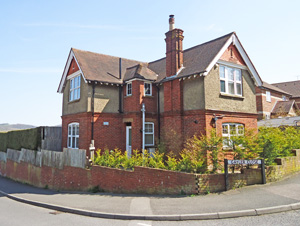
The porter's lodge at the corner of Nightingale Way and Gayler Close is the only building to survive.
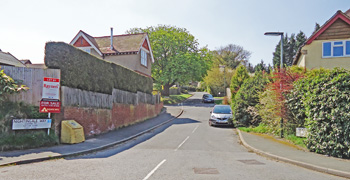
Nighingale Way, off Rabies Heath Road, occupies the driveway of the Hospital.
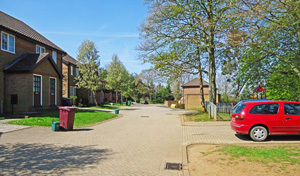
Nightingale Way, at the top of the housing estate, is the likely Hospital footprint (above and below).
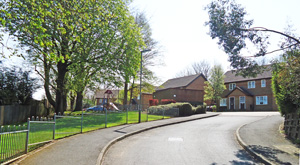
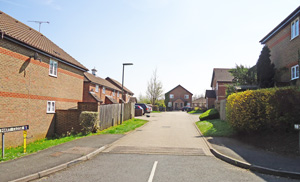
Hart Close is in the middle of the estate.
Bentley JR 1939 Annual Report of the Medical Officer of Health. Surrey, Rural District of Godstone, 23.
Ive C 1949 Dorking and Horley Rural District Annual Reports of the Medical Officer of Health and the Chief Sanitary Inspector, 8-9.
Oldman CE 1894 Annual Report of the Medical Officer of Health. Surrey, Rural District of Godstone, 9.
Oldman CE 1896 Annual Report of the Medical Officer of Health. Surrey, Rural District of Godstone, 12.
Oldman CE 1897 Annual Report of the Medical Officer of Health. Surrey, Rural District of Godstone, 10.
Robertson FW 1911 Annual Report of the Medical Officer of Health. Surrey, Rural District of Godstone, 15-17.
Robertson FW 1915 Annual Report of the Medical Officer of Health. Surrey, Rural District of Godstone, 5-9.
Robertson FW 1925 Annual Report of the Medical Officer of Health. Surrey, Rural District of Godstone, 9-11.
https://api.parliament.uk (1)
https://api.parliament.uk (2)
https://api.parliament.uk (3)
https://historic-hospitals.com
www.tandridge.gov.uk
Return to home page